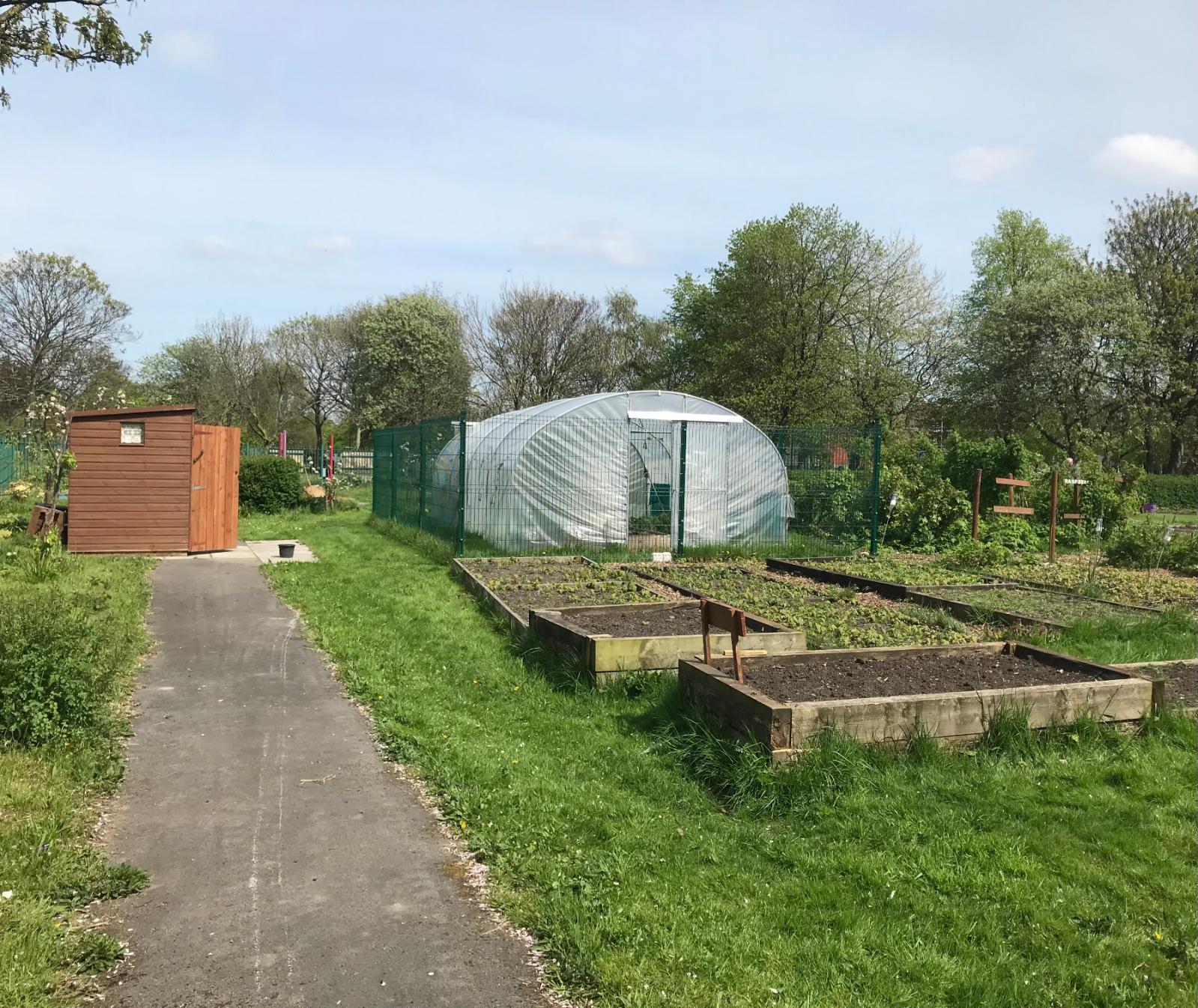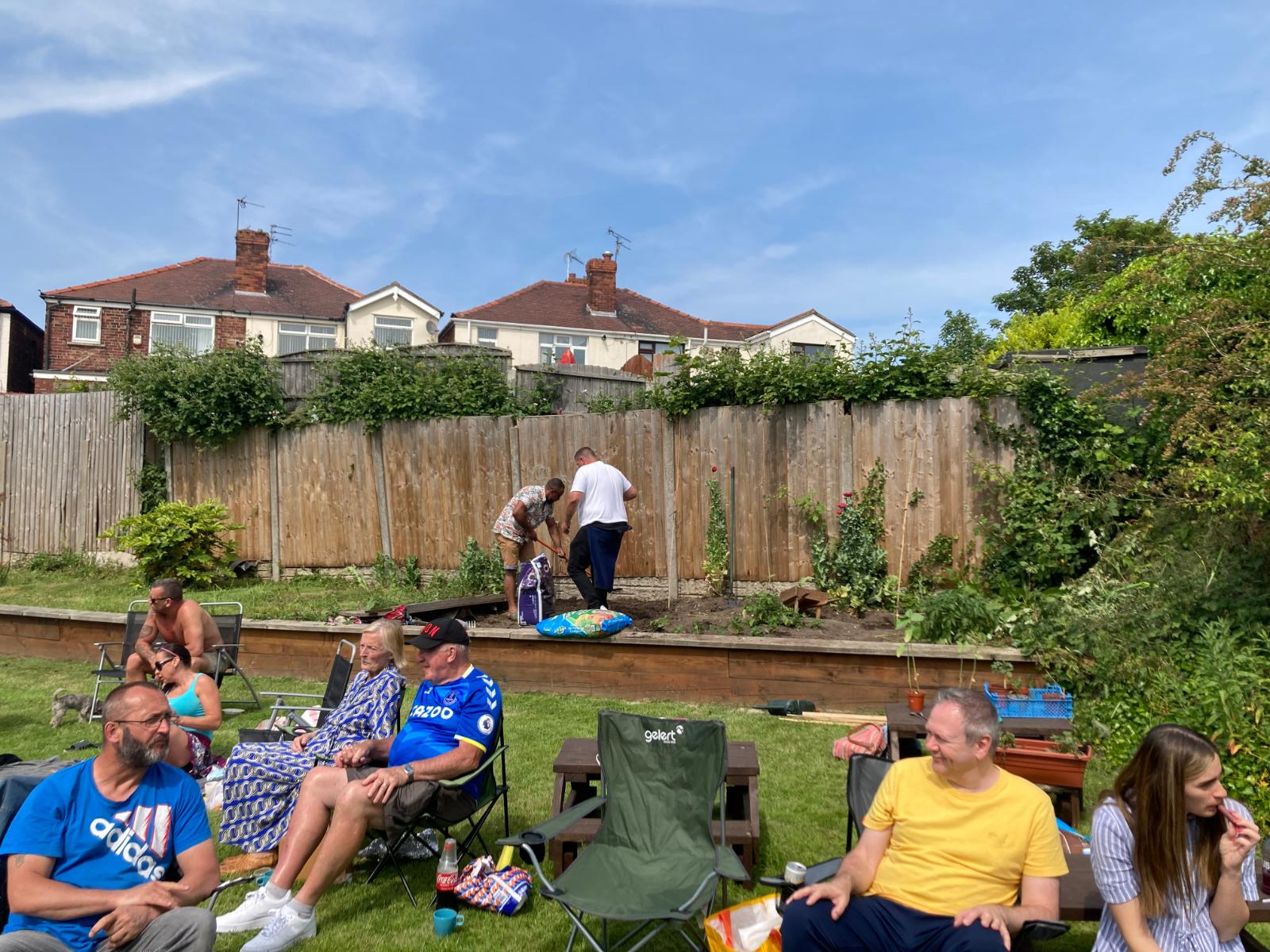A Community Garden Success Story
Kassy Price, GroundsWell's Community Blogger from Liverpool details her experience of working in and with community gardens.

The number of community gardens in the UK is on the rise. They’re popping up in all sorts of places, like disused land, parks, churches, community centres and cafes. Some neighbourhoods have even tidied up their alleyways, swapping clusters of weeds and bits of rubbish for flowers, garden furniture and home-grown vegetables.
Community gardens have so many benefits. They not only improve the aesthetics of a place, but they strengthen communities too, by giving people a chance to build relationships with their neighbours, meet new people and learn skills from each other.
Locally-grown fruit and veg is more environmentally friendly and fresher than the produce bought from supermarkets. It hasn’t been shipped in from other places or been sitting in transit for days, and it is often better quality, with more love and care put into the growing process. Not to mention it is tastier and isn’t sprayed with chemicals. Also, many gardeners would agree that cooking and eating something you have grown yourself is very satisfying and rewarding, as well as a useful skill to have.
To start a community garden, you need land and permission from whoever owns it. Public liability insurance is a must, in case somebody is injured on the property. When these things are in place, volunteers are needed, and the planning of the garden can begin. Funding is often available for community projects. Here in Merseyside, the Merseyside Funding Information Portal is a handy website to use.
Recently, I have dipped a tentative toe into the world of community gardening. I love to grow my own food at home but when I saw the spacious garden at the back of my church, Bethel House of God in Bootle, it seemed a shame to waste the space so I asked the leaders, Graham and Georgie Jones, if I could grow vegetables on it.
My husband and I removed the robust jungle of weeds that were flourishing in the raised bed, but we decided to keep it simple at first, growing just potatoes and onions. We gave the harvest to members of the congregation and after seeing what we did, people kept asking if we were going to grow more things and expressed an interest in getting involved.
To get some ideas and to find out what it takes to start a garden for the community, I visited Bootle’s North Park, just a mile away. During my visit, I found out all about the community garden there, how it began and what steps were taken to make it such a success.
Gateway Collective
North Park garden is the Buckingham Palace of community gardens. It is huge, with lots of raised beds, a polytunnel, two sections for composting (one for the garden and one for the surrounding houses to use), a composting toilet and a dining area. Most importantly, there are many volunteers and it is absolutely thriving. When I visited, there was a lot of excitement surrounding the impending delivery of a shipping container, which will be turned into a new kitchen.
The garden is part of an organisation called Gateway Collective, and was started by Ali Horton and Janet Hughes. Janet has a background in horticulture, so she specialises in growing the produce, while Ali worked for Bootle based children’s charity YKids, and deals with the operational side of things.

A polytunnel used for growing fruit and vegetables at Gateway Collective
The principle “Love your Neighbour” is at the heart of everything Gateway Collective does. Their mission is to invest in Bootle, a place they are both dedicated to. Using community gardening, they offer opportunities to the people who live there, helping them form social connections and improve their well-being. On top of that, they also provide them with access to locally grown produce.

A planter with some positive messaging.
It all began in 2014, when Janet and Ali got a narrow plot of land from Sefton council, in partnership with YKids. Originally, it was a place for them to grow fruit and veg for their chutney business.
The garden opened to the community in 2015 when Janet and Ali started helping local families to grow their own food. Wanting to expand the project, they asked the council if they could take over the field next to their plot, which had once been a five-a-side football pitch. Their wish was granted, making the garden what it is today, with the number of volunteers growing every year as well as the number of raised beds. Now it is a place for locals to gather, garden and have a gab.
People First, Gardening Second
When I asked Ali what she thinks makes a successful community garden, she said a relaxed atmosphere is important and consistency is key. The sessions are twice a week, Mondays and Wednesdays from 10am-2pm and they are on whatever the weather…rain, shine and even below freezing! In the summer, there’s an additional session on Thursday evenings.
Anyone who comes along to a session and gets their hands dirty, gets a share of the harvest. Although tending to the plants is a vital part of each session, having lunch and socialising is even more important.
Ali said, “North Park garden is about people first, and gardening second.” She told me that eating together brings people closer and as some of the volunteers live alone, the sessions are a chance for them to have a meal with friends and neighbours. Using a camping stove and produce from the garden, lunch is cooked on site. On my visit, we had a delicious vegetable chilli with wraps and salsa.

The delicious chili made with produce from the garden!
There were several people working in the garden of all different ages and abilities. Some were mowing the grass, others were weeding and planting and one man was building a new compost area out of planks of wood.
To have success with a community garden, the organisers should engage with the public in some way. Holding an open day and advertising it online is a great way of doing this, but although the North Park garden does have an online presence on Facebook and Instagram, Ali and Janet didn’t actually need to do this. The garden’s location did the work for them. It is next to a leisure centre, and is clearly visible to anybody walking past, so the news spread the old-fashioned way - by word of mouth.
Gateway Collective is registered as a community interest company, so it is a combination of both a charity and a profit-making company. It relies on donations and funding from trusts and foundations, national lotteries and the local council.
Craft workshops, such as wreath-making and candle-rolling, and other events also help to bring in funds, and raise awareness of the organisation. On the Gateway Collective website, there is an online shop where chutney, jam and preserves are sold, with all proceeds going back into the running of the garden. They also work in partnership with Made in Bootle, a group of companies who supply locally made products for gift boxes.
Having an Impact
Ali shared with me Gateway Collective’s social impact report which outlines the strategy that the organisation is taking to make progress and exactly how it has impacted the community. It is a deep dive into the project and the social value it brings to Bootle, showing the positive effects it has had on residents. It proves Gateway Collective’s success by using examples, quotes, data and stories of the lives of some of the volunteers.
By attending the gardening sessions, the volunteers say they have increased confidence, better diets and are more knowledgeable when it comes to healthy food. They made new friends, have reduced stress levels, are living more active lives and they feel as though they have been given a new purpose in life.
One volunteer found that by coming to the North Park garden, he learned about other similar groups in the area, and was opened up to a whole new network of people.Then, because he had become such a skilled gardener, he found employment and was taken on by the council as a park ranger.
There are some lovely quotes from the volunteers in the report. One of them said, “I know that when I come to the garden, I‘m not going to feel alone.” Another said, about Janet and Ali, “They have impacted my life in such an immense way, I will forever be grateful.” And another said, “I’ve completely changed my way of eating, having access to fruit and veg has really changed my diet. I’ve seen lots of health benefits.”
Analytical data has been provided, showing how much food has been grown, how much CO2e has been saved compared to buying from a supermarket and how many volunteer hours have been worked at the time of the report.
Yet even before reading the impact report, it was clear to me that the volunteers and Ali and Janet love the garden and you can see how happy it makes them. Everybody was welcoming, friendly and eager to chat and I had a great time eating with them and seeing how they operate.

The best part of the whole experience was the sense of community spirit.
Flying the Green Flag
The prestigious Green Flag Community Award was awarded to the garden and I can see why. The award is the benchmark for parks and green spaces that are run by volunteers and only community spaces of the highest standard win. They are judged on health and safety, sustainability, biodiversity and aesthetics, as well as what they have achieved, what funding has been secured and how the money has been used. One benefit to being recognised by the Green Flag award is that after the winners are published, Green Flag sites often report an increase in visitors.
With such a huge undertaking, there had to have been some hiccups along the way. Ali told me that at the beginning, they had some trouble with vandals who targeted the polytunnel. Apparently vandalism often happens when something new is built, but over time, the vandals get bored and stop bothering. Now the garden is so well established, the residents in the surrounding houses know who to contact if they see any trouble.
Another trial they have faced is how much certain things cost. Despite being a stone's throw from the leisure centre, the garden is currently off-grid. Their water is kept in storage tanks and they use gas canisters to cook. Soon, both water and electricity will be installed, but it will cost in the region of thirty-five thousand pounds.
I asked Ali what her advice was to anybody wanting to start their own community garden, and she said, “Just have a go!” Once a garden is up and running, people will want to join in. The more you do and the more people who muck in, the more others will want to get involved too and it will grow from there.
This is what I’ve been doing in the Bethel garden. First, we sowed sunflower seeds with the children, then at a recent church picnic, I brought my tools and we planted the sunflowers, along with tomatoes and strawberries. At the moment I am trying to engage other church members as much as I can, and working on the garden while people were picnicking helped immensely, as they started joining in.
It looked great when everything was in the ground, and there is plenty of room to add more plants as we go. If all goes well, it could mean growth for the community, the church and of course, the garden. Stay tuned!

Hopefully this is just the strart!
Sources
https://gatewaycollective.co.uk
Gateway Collective Social Impact Report 21/22
https://www.greenflagaward.org/
https://www.rhs.org.uk/get-involved/community-gardening/why
Kassy Price, Community Blogger
Media
groundswell@qub.ac.uk




